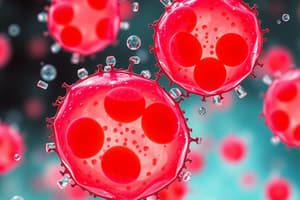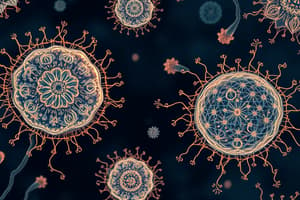Podcast
Questions and Answers
Which characteristic regarding bacterial ribosomes is correct?
Which characteristic regarding bacterial ribosomes is correct?
- They are absent in cells.
- They are 80S and located in the cytoplasm.
- They are 70S and located in the cytoplasm. (correct)
- They are 80S and located in membranes such as the endoplasmic reticulum.
In Kinyoun staining, what result would indicate the presence of acid-fast organisms?
In Kinyoun staining, what result would indicate the presence of acid-fast organisms?
- Organisms appear colorless.
- Organisms appear blue on a green background.
- Organisms appear red on a green background. (correct)
- Organisms appear red on a blue background.
The presence of metachromatic granules in bacteria can be demonstrated using which special stain?
The presence of metachromatic granules in bacteria can be demonstrated using which special stain?
- India Ink Stain
- LAMB Stain (correct)
- Dyer Stain
- Hiss Stain
Which of the special stains is specially used for visualizing the capsule of Cryptococcus neoformans?
Which of the special stains is specially used for visualizing the capsule of Cryptococcus neoformans?
A bacterium is observed to reproduce without meiosis but with the transfer of DNA. Which mode of reproduction is MOST LIKELY responsible?
A bacterium is observed to reproduce without meiosis but with the transfer of DNA. Which mode of reproduction is MOST LIKELY responsible?
Which of the following differentiates the Kinyoun stain from the Ziehl-Neelsen stain?
Which of the following differentiates the Kinyoun stain from the Ziehl-Neelsen stain?
Which of the listed cellular components is ONLY found in eukaryotic cells?
Which of the listed cellular components is ONLY found in eukaryotic cells?
What is stained by using Dorner & Schaeffer-Fulton Stains?
What is stained by using Dorner & Schaeffer-Fulton Stains?
A scientist discovers a new unicellular organism with a cell wall but no nucleus. Based on these characteristics, how should the organism be classified?
A scientist discovers a new unicellular organism with a cell wall but no nucleus. Based on these characteristics, how should the organism be classified?
If a bacterium stains blue or purple after a Gram stain, what can you conclude about its cell wall structure?
If a bacterium stains blue or purple after a Gram stain, what can you conclude about its cell wall structure?
Which of the following is NOT a characteristic typically associated with prokaryotic cells?
Which of the following is NOT a characteristic typically associated with prokaryotic cells?
A microbiologist is examining a bacterial sample and observes rod-shaped cells that stain red or pink after Gram staining. Which of the following options represents the MOST likely identification of these bacteria?
A microbiologist is examining a bacterial sample and observes rod-shaped cells that stain red or pink after Gram staining. Which of the following options represents the MOST likely identification of these bacteria?
Why is the Ziehl-Neelsen stain (hot method) necessary for identifying certain types of bacteria?
Why is the Ziehl-Neelsen stain (hot method) necessary for identifying certain types of bacteria?
Which cellular feature primarily differentiates eukaryotes from prokaryotes?
Which cellular feature primarily differentiates eukaryotes from prokaryotes?
A bacterial species is found to be unaffected by Gram staining. Which staining method would be MOST appropriate to use next, to visualize these bacteria?
A bacterial species is found to be unaffected by Gram staining. Which staining method would be MOST appropriate to use next, to visualize these bacteria?
Under a microscope, you observe spherical bacteria that stain pink after a Gram stain. Which of the following bacterial genera is MOST likely?
Under a microscope, you observe spherical bacteria that stain pink after a Gram stain. Which of the following bacterial genera is MOST likely?
Flashcards
Primary Stain
Primary Stain
Aqueous stain used to color microorganisms in microscopy.
Acid-Fast Organisms
Acid-Fast Organisms
Bacteria that appear red on a blue background when stained.
Kinyoun Stain
Kinyoun Stain
A cold staining method that uses oil-based primary stain without heat.
Special Stains
Special Stains
Signup and view all the flashcards
LAMB Stain
LAMB Stain
Signup and view all the flashcards
Dyer Stain
Dyer Stain
Signup and view all the flashcards
India Ink/Nigrosine
India Ink/Nigrosine
Signup and view all the flashcards
Ribosomes
Ribosomes
Signup and view all the flashcards
Gram Stain
Gram Stain
Signup and view all the flashcards
Gram-positive Bacteria
Gram-positive Bacteria
Signup and view all the flashcards
Gram-negative Bacteria
Gram-negative Bacteria
Signup and view all the flashcards
General Rule for Cocci
General Rule for Cocci
Signup and view all the flashcards
General Rule for Bacilli
General Rule for Bacilli
Signup and view all the flashcards
Acid-Fast Stain
Acid-Fast Stain
Signup and view all the flashcards
Ziehl-Neelsen Stain
Ziehl-Neelsen Stain
Signup and view all the flashcards
Prokaryotes vs Eukaryotes
Prokaryotes vs Eukaryotes
Signup and view all the flashcards
Study Notes
Prokaryotes vs. Eukaryotes
-
Prokaryotes:
- Genetic material not enclosed within a membrane, typically circular
- Smaller size (1-4 µm)
- Mostly unicellular
- No true nucleus, nucleoid region
- Simple cell wall
- Cell division by budding or binary fission
- No meiosis, DNA transfer only
- Lack cytoskeleton and mesosomes
- 70S ribosomes located in cytoplasm
- Lack membrane-bound organelles
- Lack extrachromosomal plasmids
- Short cell cycle (20-60 minutes)
-
Eukaryotes:
- Genetic material enclosed within a membrane, linear
- Larger size (greater than 5 µm)
- Mostly multicellular
- True nucleus enclosed by a membrane
- Complex cell wall
- Cell division by mitosis
- Meiosis and sexual reproduction
- Present cytoskeleton and mesosomes
- 80S ribosomes located in cytoplasm or organelles
- Present membrane-bound organelles
- Present extrachromosomal plasmids
- Longer cell cycle (12-24 hours)
Gram Stain
- Differentiates Gram-positive and Gram-negative bacteria.
- Gram-positive bacteria stain purple.
- Gram-negative bacteria stain red or pink.
- General rule: Most cocci are Gram-positive, except Neisseria, Veillonella, and Branhamella. Most bacilli are Gram-negative, except Corynebacterium, Clostridium, Bacillus, and Mycobacterium
Acid-Fast Stain
- Used for bacteria with high lipid content in their cell walls which cannot be stained using Gram stain.
- Two methods:
- Ziehl-Neelsen (Hot Method): Requires steaming after primary dye application
- Kinyoun (Cold Method): Does not require heat, oil-based primary stain.
- Acid-fast organisms stain red on a blue or green background.
Special Stains
- Used to demonstrate specific bacterial cell structures.
- Examples:
- LAMB Stain (Loeffler Alkaline Methylene Blue): Stains metachromatic granules, capsule, or slime layer
- Hiss Stain: Stains capsules or slime layers
- Dyer Stain: Stains cell walls
- Fischer-Conn Stain: Stains flagella
- Dorner and Schaeffer-Fulton Stains: Stains spores
- India Ink/Nigrosine: Stains capsules of Cryptococcus neoformans
Differential Stains
- Differentiate one group of bacteria from another.
- Two common types: Gram stain and acid-fast stain.
Studying That Suits You
Use AI to generate personalized quizzes and flashcards to suit your learning preferences.




